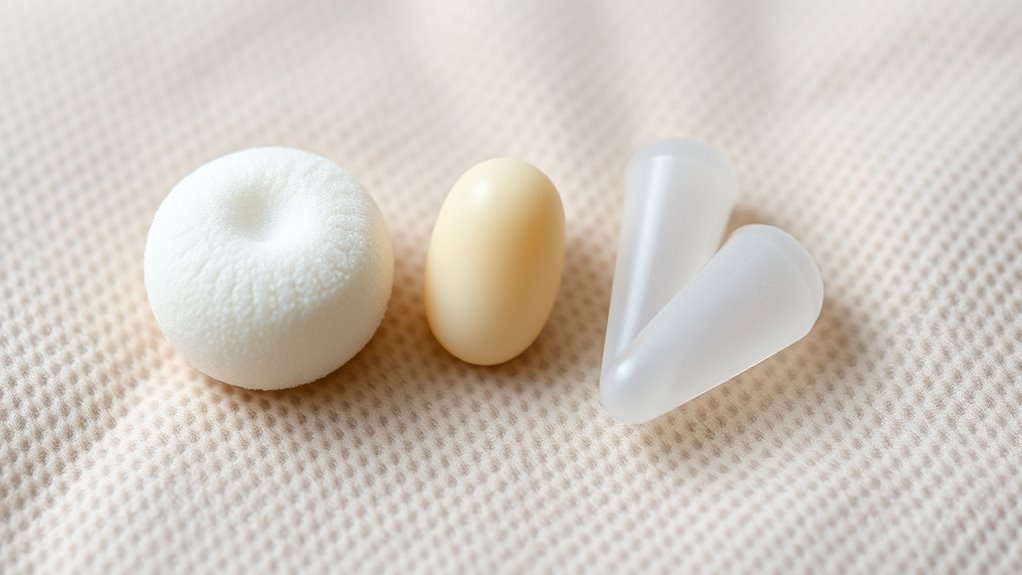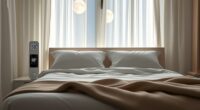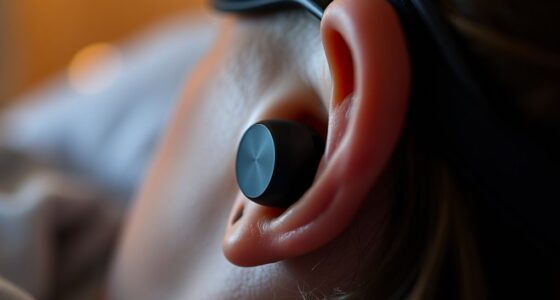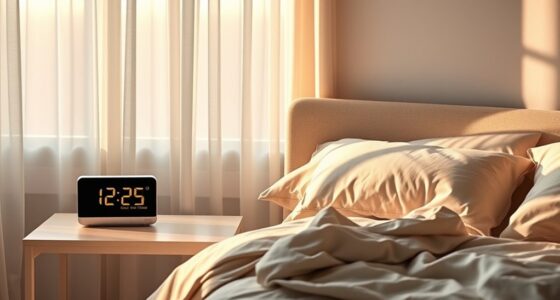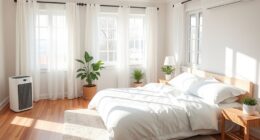When choosing earplugs for sleep, consider comfort, noise reduction, and durability. Foam earplugs mold to your ear for soft comfort and work well against high-frequency sounds, but they are usually single-use. Wax conforms for a customized fit and is reusable, while silicone offers flexibility and long-term durability for extended wear. Understanding these differences helps you pick the best option for better sleep—exploring more will guide you even further.
Key Takeaways
- Material comfort varies: foam is soft and moldable, wax conforms to ear shape, and silicone is flexible for extended wear.
- Noise reduction effectiveness depends on design and material; foam muffles high frequencies, silicone suits low frequencies.
- Reusable options like wax and silicone are more durable and cost-effective over time than single-use foam earplugs.
- Proper insertion and material choice reduce irritation, pressure, and improve overall sleep quality.
- Consider personal preferences, noise environment, and longevity when choosing between foam, wax, or silicone earplugs.
Material Composition and Comfort
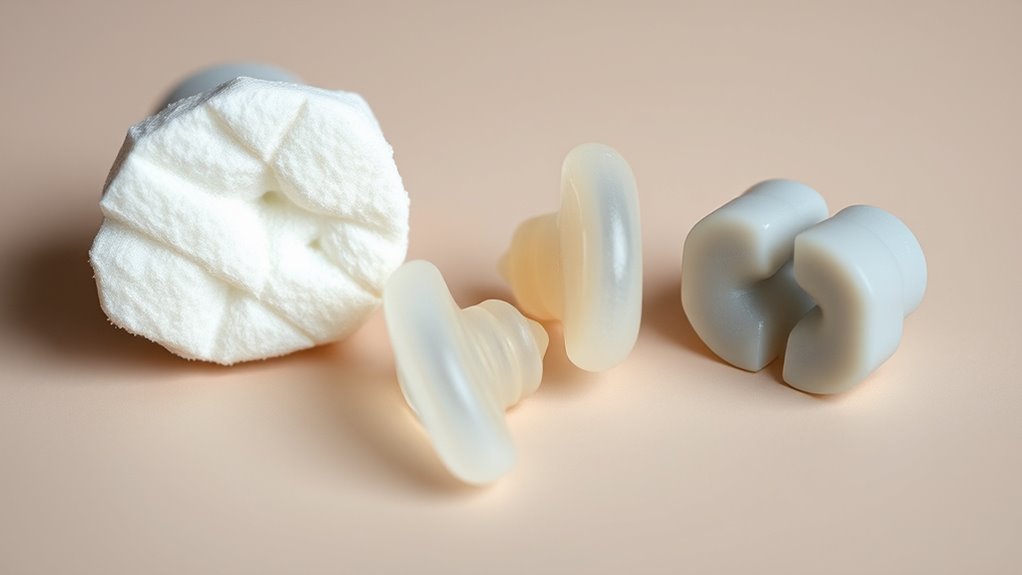
When choosing earplugs for sleeping, the material composition plays a crucial role in comfort and effectiveness. The earplug material determines how well they fit and how comfortable they feel throughout the night. Foam earplugs are soft and moldable, offering a high comfort level for many users, but they can sometimes cause pressure or irritation. Wax earplugs provide a more customized fit, conforming to your ear shape and enhancing comfort. Silicone earplugs are flexible and smooth, making them easy to insert and comfortable for extended wear. The right material can reduce discomfort and prevent irritation, ensuring you stay asleep longer. Ultimately, selecting earplugs with a suitable material composition helps you achieve a better sleep experience without sacrificing comfort. material composition also influences how well earplugs block out noise, which is essential for restful sleep.
Effectiveness and Noise Reduction Capabilities
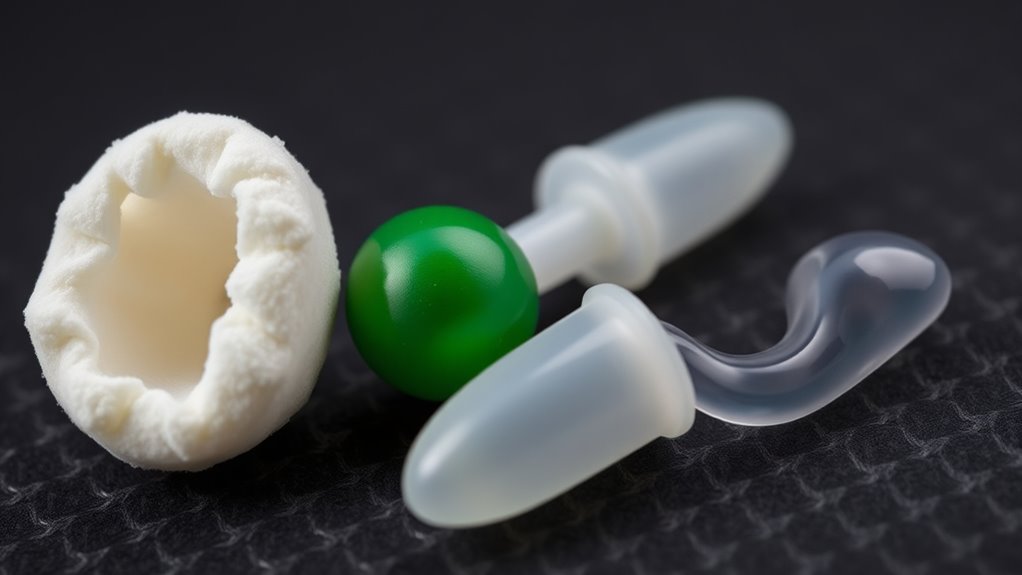
The effectiveness of earplugs in reducing noise depends largely on their design and material. Well-designed earplugs can considerably improve your sleep hygiene by blocking out disruptive sounds. Different materials target noise frequency ranges more effectively; for example, foam earplugs excel at muffling high-frequency sounds, while silicone molds better to low-frequency noise. Your goal is to minimize interruptions and create a quiet environment that supports deep, restful sleep. Proper insertion is essential for maximum noise reduction—improper fit can reduce effectiveness. Keep in mind that individual differences in ear shape and the noise environment influence how well earplugs work. Choosing the right type based on noise characteristics ensures you get the best sleep quality possible. AI technology can also assist in personalizing earplug recommendations based on individual noise environments for improved sleep outcomes.
Durability, Reusability, and Cost Considerations
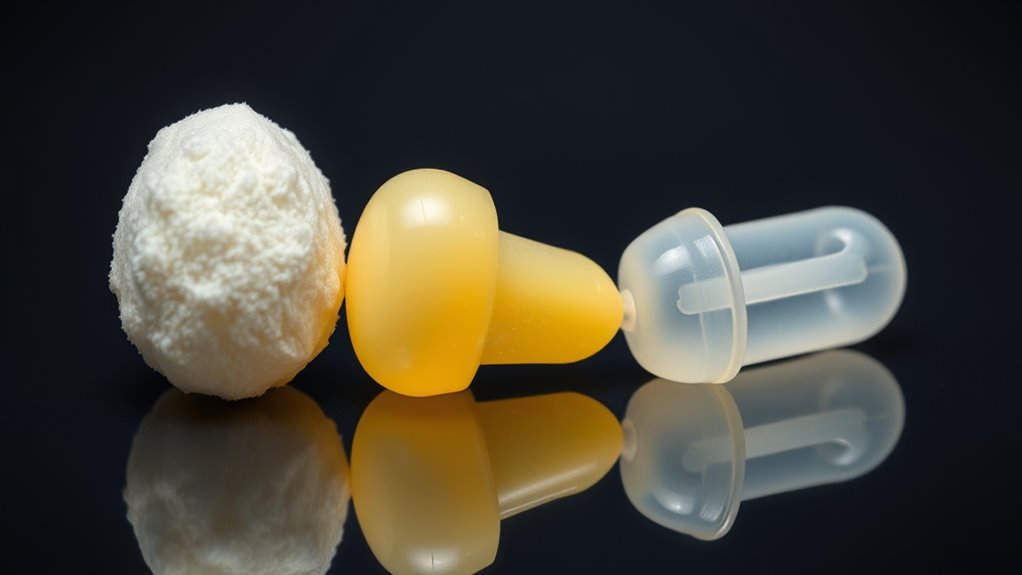
Choosing earplugs that are durable and reusable can save you money in the long run, especially since quality designs tend to withstand daily use better. A durability comparison helps you assess how well materials hold up over time, while reusability factors influence how often you need replacements. Cost analysis shows that investing in reusable earplugs, like silicone, can be more economical than constantly buying disposables. Material longevity varies across types; foam tends to wear out faster, whereas wax and silicone last longer. Consider this table for clarity:
| Material | Durability Comparison | Reusability Factors | Cost Analysis |
|---|---|---|---|
| Foam | Less durable | Single-use | Lower initial cost |
| Wax | Moderate durability | Reusable | Moderate cost |
| Silicone | Highly durable | Reusable | Higher upfront cost |
Additionally, selecting appropriate materials based on your specific needs can greatly improve comfort and effectiveness.
Frequently Asked Questions
Are There Hypoallergenic Earplug Options for Sensitive Skin?
Yes, there are hypoallergenic earplug options for sensitive skin. You can look for earplugs made from hypoallergenic materials like silicone, soft foam, or wax, which are designed to minimize irritation. Sensitive skin options typically avoid latex and other common allergens. Always check product labels for hypoallergenic certification, and consider trying different types to find the most comfortable and safe fit for your skin.
How Do Different Earplug Types Affect Sleep Quality and REM Cycles?
Different earplug types impact your sleep quality and REM cycles through sound attenuation and noise reduction. Foam earplugs often provide the best noise reduction, helping you block out more sound and achieve deeper sleep. Wax earplugs offer good sound attenuation with better comfort, while silicone earplugs provide moderate noise reduction and are reusable. Choosing the right type depends on your noise environment and comfort needs, ultimately improving your sleep and REM cycles.
Can Earplugs Cause Ear Infections or Other Health Issues?
You might wonder if earplugs can cause health issues. While they can lead to earwax buildup if used improperly, they rarely cause infections or hearing loss when cleaned and used correctly. Avoid inserting them too deep, and remove them regularly to prevent discomfort. Proper hygiene helps reduce risks, so you stay safe and protect your ear health while enjoying better sleep without worries about infections or hearing problems.
What Is the Best Storage Method to Keep Earplugs Clean?
Properly protecting your earplug hygiene starts with smart storage solutions. Use clean, sealed storage containers to keep dirt and debris away, preventing bacteria buildup. Always guarantee your earplugs are completely dry before storing them, and avoid sharing them with others. Regularly sanitize storage cases and replace earplugs when they show signs of wear. This simple strategy keeps your earplugs clean, safe, and ready for restful, infection-free sleep.
Are There Specific Earplugs Recommended for Side Sleepers?
If you’re a side sleeper, look for earplugs with custom earplug shapes that fit comfortably without putting pressure on your ear canal. Opt for earplugs with high noise reduction ratings to block out sound effectively. Silicone or wax options often mold to your ear’s shape, providing a snug fit. Avoid bulky foam plugs, which might be uncomfortable when lying on your side. Custom shapes guarantee comfort and better sleep quality.
Conclusion
Choosing the right earplugs can drastically improve your sleep quality. Foam, wax, and silicone each offer unique benefits, so pick what suits your comfort and noise reduction needs. Did you know that over 60% of people using earplugs report better sleep? By considering material, effectiveness, and durability, you can find the perfect fit. Investing in quality earplugs is a simple step toward more restful nights and waking up refreshed.
